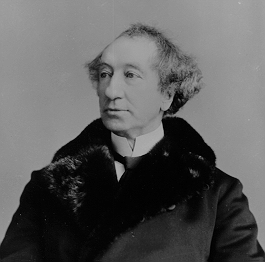The 1850’s were a time of political turmoil in Canada. After the Act of Union of 1841, Upper and Lower Canada were united under a single government, with equal representation from Canada West and Canada East. In 1847 Canada was given Responsible Government. In 1851 after the resignation of the Baldwin-Lafontaine administration, Francis Hincks and Augustin Morin led the reform administration. The Municipal Loan Fund Act was passed that allowed municipalities and railway companies to borrow money on credit from the provincial government. In the same year a political party led by George Brown of Canada West called the Clear Grits was formed. These English-Canadian reformers advocated democracy, Representation by Population, the secret ballot, universal suffrage and biennial elections.
 In 1854 the reform administration resigned. The moderate reformers of the East and the West united and formed the Liberal-Conservative Party. Under the leadership of John A. Macdonald (picture on right), seigneurial tenure was abolished and the province of Canada bought the rights of the seigneurs. (The Roman Catholic Church was exempt from the Act.) Habitant farmers were allowed to buy or rent smallholdings and there was the secularization of the clergy. Funds from the clergy reserves were given to municipalities in proportion to their population. In June of 1854 a 12-year treaty was signed which made provision for reciprocal free trade in coal, fish, farm and forest products. American vessels were given inshore fishing rights and allowed on St. Lawrence and Canadian canals. In return, Canada was given access to Lake Michigan.
In 1854 the reform administration resigned. The moderate reformers of the East and the West united and formed the Liberal-Conservative Party. Under the leadership of John A. Macdonald (picture on right), seigneurial tenure was abolished and the province of Canada bought the rights of the seigneurs. (The Roman Catholic Church was exempt from the Act.) Habitant farmers were allowed to buy or rent smallholdings and there was the secularization of the clergy. Funds from the clergy reserves were given to municipalities in proportion to their population. In June of 1854 a 12-year treaty was signed which made provision for reciprocal free trade in coal, fish, farm and forest products. American vessels were given inshore fishing rights and allowed on St. Lawrence and Canadian canals. In return, Canada was given access to Lake Michigan.
There were two other political parties during the 1850’s, Le Parti Rouge and Le Parti Bleus, in Canada East. Le Parti Rouge was led by Antoine-Aime Dorion and was a radical party of young democrats. They hated the English and were French anticlerical radicalists. The party advocated the rights of Canadiens and American-type republicanism. The party eventually seeked annexation with the United States. Le Parti Bleus, led by George-Etienne Cartier favored co-operation between French and English speaking Canadians.
All of the political parties were evenly balanced in the legislature and this created a Political Deadlock. The Liberal-Conservative Party which consisted mostly of French-Canadian members and the Reform Party of English-Canadian members displayed racial and religious prejudices. Canada West and Canada East couldn’t agree as to how money should be spent. The "Double Majority Policy" where any important measure had to receive a majority of votes from the representatives of Canada East and Canada West resulted in very few measures being passed, because often members of Canada East and Canada West voted against each other in the legislature.
In 1858 the Clear Grits and Liberal-Conservative Parties began to advocate British North American Unity. They were motivated by western expansion and they knew that the Hudson Bay Company trade monopoly was about to expire.